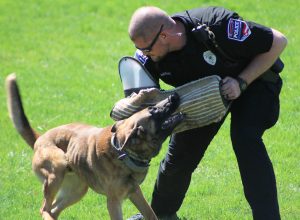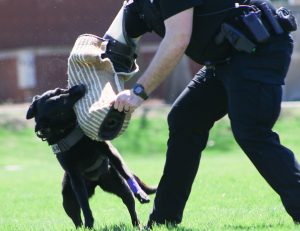The audience was excited as a K-9 officer brought in by a police officer salivated, waiting for a command to attack another officer who was taunting the dog, slamming his hands against the padding on his arm. When spoken to by their partner, the dog took off running, then latched onto the officer’s arm. This was one part of the routine Martinsville Police Officers displayed with their three dogs on April 9 at the Dog Demo event, hosted by the University of Indianapolis’ criminal justice honor society Alpha Phi Sigma. The other part included the K-9 units sniffing out drugs from boxes laid out on the ground. The dogs sat down to signify they found what they were looking for.
Senior psychology and criminal justice double major Brielle Adney was the one to pitch the idea at a general meeting of the honor society. She asked her uncle, who was a K-9-unit officer, for his help, and he agreed.
K-9 Officer Edo bites Officer Ryan Manley during a demonstration on Smith Mall on April 9. The dog was excited for the exercise.
“It’s really a chance for people who are interested in policing to see that there are other opportunities than just a police officer, where they can have a drug dog or they can do that type of other career, and [the event is] kind of interesting because I know pretty much everyone likes dogs,” Adney said. “So it’s kind of fun to come out and see what they do… I think it’s pretty interesting even if you’re not interested in criminal justice or anything [that goes] with it.”
The event began with an introduction from the three officers and an explanation of what was about to occur, then dogs were brought out one by one. Each K-9 sniffed out the illegal substances and demonstrated how they catch suspects, using a durable sleeve for the officer’s safety. The sleeve, as the officers called it, is made out of a material called jute that is lined on the outside with plastic and padding on the inside. Officers use the sleeve when they begin training K-9’s as puppies.
Officer Dustin Tarr said that the sleeve is like a toy to the dogs because of how long they have been able to attack it. The dog then runs to attack the sleeve, biting and hanging on until they are told to stop. The pressure from the bite can be felt through the sleeve, but it does not injure them, Tarr said.
The reason the dogs are able to sniff out the illegal substances is because of their sharp nose and acute training, according to Tarr. The dogs are trained to think the smell of drugs is one of their toys. They command the dog to go fetch their toys, and since the smell is the same as the substance, that is how they sniff out drugs.
Getting the dogs here was a collaboration between Adney and Tarr, Adney had to make sure people knew about the event, while Tarr had to get shot records of the dogs to the school to be able to bring them here.
“We very rarely turn anyone down for the K-9 demonstrations just because it’s such a tool, and everybody wants to see [the dogs] and we rely on donations for equipment and such because it [costs] so much to keep them in service,” Tarr said.
Junior criminal justice major and Secretary of Alpha Phi Sigma Delanie Kent said she went to the event because she was interested in seeing what the K-9 units do. She said she learned a lot from the event, Kent said, because she has the same dog as two of the officers, a Belgian Shepherd Malinois and the explanation given at the beginning of the demo helped explain her dog’s aggressive and attentive behaviour. Kent’s favorite part of the evening, she said, was the demonstration with the sleeve.
Jada, a Dutch Shepard, bites the sleeve of Officer Manley during the event. She is currently being trained by Martinsville Police.
Tarr said that if one wants to go into law enforcement, he or she should consider looking at the K-9 track of the force. While each process and standards differ from department to department, according to Tarr, the process at his station is having two or three years of service on the force and showing an interest prior to applying for the unit. His dog, Edo, came from a shelter in Rhode Island that trains puppies to be ready for the law enforcement. There the owner of the shelter does a “tennis ball test” to see if the dogs were able to be trained. The test is simply throwing a tennis ball and commanding the dog to fetch it, and if they do, it shows that they can take commands and have the possibility to be trained.
“It’s very rewarding. It’s an enjoyable thing…,” Tarr said. “The bond that you build with your dog, it becomes your partner and you trust them just as much as they trust you.”







